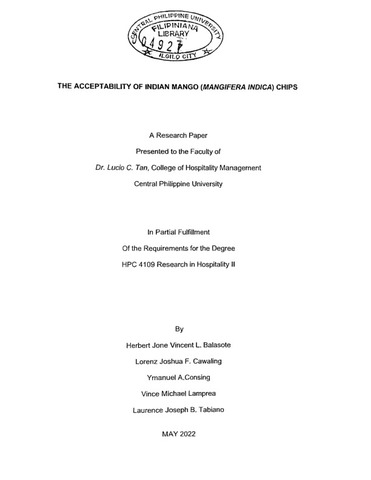Ipakita ang simpleng tala ng item
The acceptability of Indian mango (Mangifera indica) chips
| dc.contributor.adviser | Luceño, Myrna T. | |
| dc.contributor.author | Balasote, Herbert Jone Vincent L. | |
| dc.contributor.author | Cawaling, Lorenz Joshua F. | |
| dc.contributor.author | Consing, Ymanuel A. | |
| dc.contributor.author | Lamprea, Vince MIchael | |
| dc.contributor.author | Tabiano, Laurence Joseph B. | |
| dc.date.accessioned | 2023-11-03T00:54:50Z | |
| dc.date.available | 2023-11-03T00:54:50Z | |
| dc.date.issued | 2022-05 | |
| dc.identifier.citation | Balasote, H. J. V. L., Cawaling, L. J. F., Consing, Y. A., Lamprea, V. M., & Tabiano, L. J. B. (2022). The acceptability of Indian mango (Mangifera indica) chips [Unpublished special paper]. Central Philippine University, Jaro, Iloilo City. | en_US |
| dc.identifier.uri | https://hdl.handle.net/20.500.12852/2854 | |
| dc.description | Abstract only | en_US |
| dc.description.abstract | Mangoes are known to be the country’s national fruit and Indian mango (Mangifera indica) is a very popular variety of mango in the Philippines. Often times though, they are overproduced and unused. This study aimed to determine the acceptability of Indian mango (Mangifera indica) when produced as chips in terms of aroma, appearance, flavor, texture, and overall acceptability when grouped according to age and sex. The main purpose of making Indian mango (Mangifera indica) as chips is to provide a unique product where people of all ages will be able to enjoy, consisting of the bountiful health benefits from the mango and to determine the cost of production of the chips. The study was conducted in Brgy. Santa Rosa, Mandurriao, Iloilo City using the accidental sampling technique. The experimental research design was used where researchers made three trials with one standardized result. Thirty-five respondents were categorized by age and sex and assessed the product's sensory qualities. Nineteen were male and 16 were females, 12 of whom are categorized as young, 10 in the middle age and 13 were old age. Results show both genders highly accepted the Indian mango (Mangifera indica) chips. In age, similar findings were found, the product was highly accepted by the three age groups, however, the results show that there is a significant difference in flavor. In conclusion, the respondents acknowledged the acceptability of the Indian mango (Mangifera indica) chips regardless of the differences of age and sex and that the cost of production was very minimal. | en_US |
| dc.format.extent | vii, 85 leaves | en_US |
| dc.language.iso | en | en_US |
| dc.subject.lcc | TX 911 .B35 2022 | en_US |
| dc.subject.lcsh | Mango--Varieties | en_US |
| dc.subject.lcsh | Snack foods | en_US |
| dc.title | The acceptability of Indian mango (Mangifera indica) chips | en_US |
| dc.type | Special paper | en_US |
| dcterms.accessRights | Not publicly accessible | en_US |
| dc.description.bibliographicalreferences | Includes bibliographical references | en_US |
| dc.contributor.chair | Hisuan, Armando M. Jr. | |
| dc.contributor.committeemember | Tan, Denie Erwin W. | |
| dc.contributor.committeemember | Bayot, Maria Patricia S. | |
| dc.contributor.department | College of Hospitality Management | en_US |
| dc.description.degree | Bachelor of Science in Hospitality Management | en_US |
| local.subject | Indian mango | en_US |
| local.subject.scientificname | Mangifera indica | en_US |


